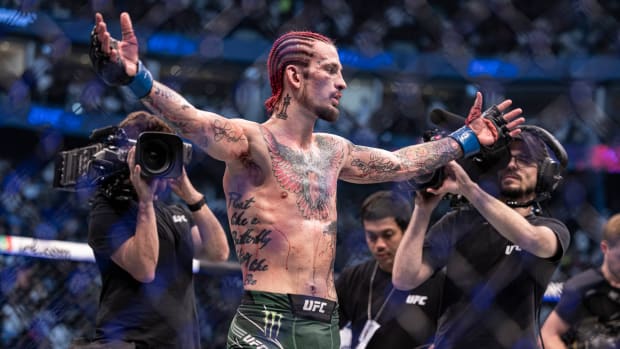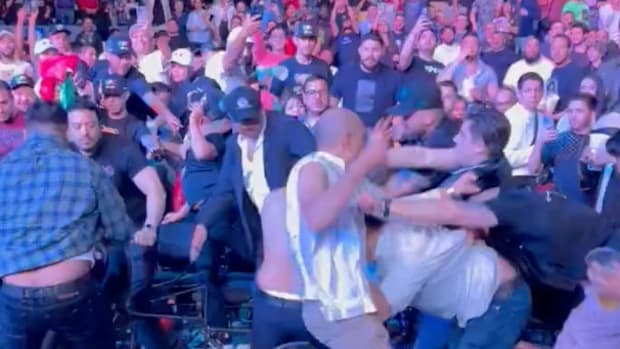How Maranhao's blackout should've been -- and wasn't -- handled
GIF via Fansided
It seemed too outrageous, but the video doesn't lie. The fighter slumps off the stool between rounds, face-plants the canvas, and is allowed to continue fighting. As commentator Pat Miletich put it during Axs TV 's live telecast of the event: "This is when bad things happen."
Bad things happened all right at Resurrection Fighting Alliance 14 on Friday in Cheyenne, Wy. The bout, overseen by the Wyoming State Board of Mixed Martial Arts, pitted Junior Maranhao against Matt Manzanares in a flyweight championship fight. Manzanares caught Maranhao in a tight triangle choke with 45 seconds left in the fourth round. Maranhao survived to the bell and made it back to his corner. His cornermen left him unattended to argue with the referee about a "phantom" stop that facilitated the triangle choke. Then Maranhao slid right off his stool. (Maranhao went on to lose a split decision.)
There were numerous ways the fight could have been stopped at this point. There were checks and balances in place. They all failed. Here's how it happened:
THE COMMISSION
What happened: The commission, seated cageside, did not stop the fight when Maranhao fell.
What should have happened: Of all those sitting along the cage's perimeter, it's the commission and staff's responsibility -- not to mention its job -- to act when fighters slide off stools. They don't have to impart that power solely on the referee and ringside physician.
"The commission event supervisor does not have to sit idly by and can also halt a contest if egregious health and safety violations are occurring," said Nick Lembo, the Chair of the Association of Boxing Commission's MMA Training and Officials Committee, via email.
So, why didn't anyone react? On Saturday, the Wyoming State Board of Mixed Martial Arts issued a statement to explain its actions. However, the WSBMMA's account was inconsistent to what was captured on camera . On Monday, WSBMMA commissioner Jerry Davis told SI.com that the statement was "adequate" and that the board would not readily comment further on the incident.
ABC President Tim Lueckenhoff issued a release on Monday, extending the assistance of the ABC Chairs Nick Lembo and Sherry Wulkan. He also stated the ABC's concern over the "handing of this incident" and the "later public statement released by Wyoming."
If issues are not addressed by the Wyoming Board, Lueckenhoff would have the option to contact the Wyoming state attorney general for further assistance.
"Our goal is to push them into fixing the problems that they have," said Lueckenhoff. "They've only been regulating for about three years. I'd say they've regulated less than 30 shows. They just don't have that experience level and they need to reach out."
THE REFEREE
What happened: At the bell, the referee conversed with Maranhao's disgruntled cornermen until they suddenly disengaged him to attend to their dropped fighter. The referee followed the cornermen and watched them revive and move the fighter. The referee stood directly in front of the fighter as he was pulled back onto his stool. He failed to act upon Maranhao's fall.
What should have happened:Senior MMA referee John McCarthy said a referee should have no qualms immediately stopping a bout after a fighter blacks out.
"What the cornermen say doesn't matter. We go toward the health and safety of the fighter," said McCarthy, an MMA referee for 20 years. "I've had someone pass out between rounds: the fight's over."
McCarthy said he's also been engaged by cornermen between rounds. "During the one-minute break, we'll tell the cornerman that if he wants to talk, that it's his time, but he's wasting it not being with his fighter."
McCarthy said he encourages cornermen to speak with him after the bout, clearing the way for him to check on both fighters.
"You want to see the interactions between the fighter and the cornermen," said McCarthy. "Is the fighter listening to the cornermen? Is his attention toward what is being told to him? All of this helps you in determining if this guy's good to go or if this guy's having problems. Obviously, when a guy goes off the stool, he's got problems."
THE RINGSIDE PHYSICIAN
What happened? The ringside physician was either called to the cage or entered himself after Maranhao had already recovered his stool. The physician spoke to the cornermen, his hand on Maranhao's back, but did not speak directly to or examine the fighter.
What should have happened? "If I witnessed a fighter falling off their stool and collapsing onto the canvas, that fight is over, without regard to how they appear after regaining consciousness," said ABC Medical Chair Sherry Wulkan.
In New Jersey, Wulkan said a doctor doesn't have to wait for the referee's signal to enter the cage.
"A ringside physician should not always wait for the referee to request that they enter the ring or cage. A case in point is a witnessed collapse," said Wulkan. "That being said, the physician should work in tandem with the referee and the inspector to notice and address medical concerns."
Wulkan said that cases of delayed response, where a fighter will return to their corner and then collapse, are extra cause for concern.
"Even if the athlete revives quickly, there's no way to assess what the underlying cause of the collapse was. To allow the fight to continue at that point would go against what our purpose is," Wulkan said.
Wulkan said she generally doesn't speak to the cornermen in assessing a fighter's condition.
"Some corners seem to feel that one of their duties is to dissuade the ringside physician from recommending a bout stoppage," said Wulkan. "When teaching seminars or training incoming ringside physicians, I instruct them to obtain information directly from the fighter. The fighter is my 'patient' and I need to make a proper assessment. I choose to interact directly with the fighter. Neurological assessments include, in part, checking pupillary responses; orientation to person, place and time; balance and the following of simple commands."
The ABC guidelines require a minimum of two ringside physicians cageside -- one fixed on each fighter. It's not known how many physicians were employed by the WSBMMA last Friday.
THE CORNER INSPECTOR:
What happened? When Maranhao fell, there was no corner inspector present.
What should have happened? "There should be an inspector assigned to each corner tasked to specifically watch his/her contestant in between rounds," said Lembo. "There is no way that the corner inspector should miss the contestant completely falling off his stool. If the physicians and referee somehow were distracted or otherwise engaged, the corner inspector should not have been; and should have immediately shown concern and alerted the referee and physician."
THE CORNERMEN:
What happened: Noticing their fighter going down behind them, the cornermen left their argument with the referee, rushed to Maranhao's side and pulled him back up on his stool. When asked by the physician if their fighter was O.K., they gave an affirmative.
What should have happened: Lembo said blame can be placed on the corner, but the commission's duty to ensure the fighter's health and safety trumps all.
"The corner may have an emotional and/or financial interest in their fighter," explained Lembo. "Further, they may not be overly knowledgeable about medical safety issues. If the commission has to rely on the corner to throw in the towel after a fighter openly collapses during the contest, then the commission has not lived up to their regulatory duties."




